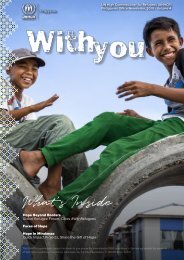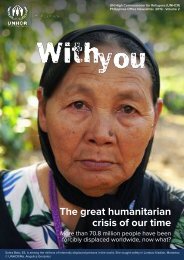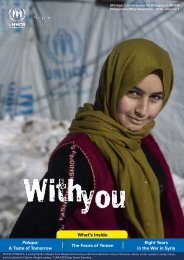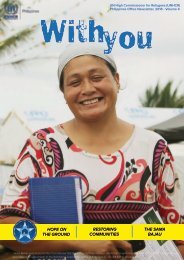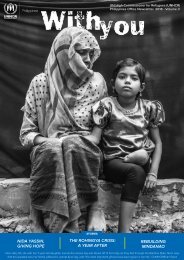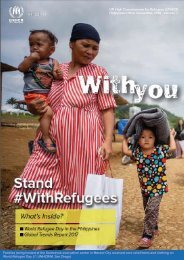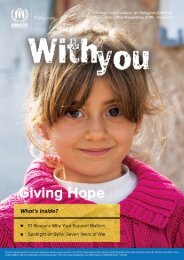With You, 2019 Volume 3
Create successful ePaper yourself
Turn your PDF publications into a flip-book with our unique Google optimized e-Paper software.
UN High Commissioner for Refugees (UNHCR)<br />
Philippines Office Newsletter, <strong>2019</strong> - <strong>Volume</strong> 3<br />
What’s Inside<br />
Stories from Camp<br />
Atom Araullo looks back at the milestones of the Rohingya crisis<br />
In Sarimanok, an education for adults<br />
Two women and their sacrifice for learning<br />
Cooking for Tomorrow<br />
In the midst of ruin, Maranao women keep traditions alive<br />
Atom Araullo surveys Kutapalong Camp, the temporary home to nearly a million Rohingya refugees.<br />
© UNHCR / Joshua Paul
Message from the Representative<br />
Message<br />
from the<br />
Representative<br />
To our donor,<br />
Warmest greetings!<br />
© UNHCR / Althea Gonzales<br />
I discovered that the holiday season comes early in the<br />
Philippines with Christmas carols playing in the malls<br />
already. I am looking forward to the last quarter of the year<br />
because this is the time that we are able to share with you<br />
all the good work that you’ve done for the year.<br />
This issue of <strong>With</strong><strong>You</strong> is a preview to that. Here, we share<br />
the stories of people who give what they could with other<br />
people. The act of sharing is seen even in some of the<br />
most dire situations in the world.<br />
“Together, we<br />
give help,<br />
hope, and<br />
home.”<br />
There are times in life when we share what little we have<br />
to others – not because we feel better about ourselves,<br />
not because we get something in exchange, but because<br />
it is at the core of who we are as humans. And this is what I<br />
would like to share with you all - the spirit of giving.<br />
This is thread is something that is evident in our<br />
government, corporate, and non-government partners, but<br />
especially in you. <strong>You</strong> have not only shared hope, but you<br />
have acted on your kindness everytime you renew your<br />
commitment to refugees and displaced families<br />
Maraming salamat po.<br />
Sincerely,<br />
Shinji Kubo<br />
Representative<br />
UNHCR Philippines<br />
2 <strong>With</strong> <strong>You</strong> | Vol. 3, <strong>2019</strong>
In the Philippines<br />
In Sarimanok, a few lessons for adults<br />
Two women highlight the importance of sacrifice and learning<br />
The Sarimanok evacuation center in Marawi City In the learning facility, the children sing nursery<br />
remains home to some one hundred families who have rhymes in their mother tongue and learn about the<br />
yet to move to transitory housing units. In spite of the alphabet. The classroom setup helps bring back<br />
conditions in the community, resilience is present in the some semblance of normalcy as the families begin to<br />
families who still reside in Sarimanok. Among those who rebuild their lives.<br />
show this spirit is Jaslia.<br />
She makes ends meet through a small sari-sari store<br />
she has set up in front of her tent, and through small<br />
amounts of financial assistance she receives from<br />
her family outside of Marawi. Every penny goes to<br />
her family’s needs.<br />
Despite finding herself in a dire situation, she chose<br />
to remain here in a bid of sacrifice for the sake of<br />
her children’s education, as well as to remain a<br />
leader figure in a community she has grown to care<br />
for.<br />
Hakima and Nurhana are both in Kindergarten while<br />
Rahima has started first grade. Their favorite subjects<br />
are Math and English. As they spent the last two<br />
years of their lives living in displacement, the children<br />
have put some thought<br />
into what they want to<br />
do when they grow up:<br />
to help others who are<br />
in need, drawing<br />
inspiration from the<br />
people who helped<br />
them.<br />
© UNHCR / Althea Gonzales, Marrian Ching<br />
Out of her five children, only one stays with Jaslia<br />
and her husband in the evacuation center. Three of<br />
her children stay with their aunt in a nearby<br />
municipality, while another<br />
resides with relatives on Luzon<br />
island.<br />
“I see three of my children<br />
every weekend when they<br />
come to visit. They stay with<br />
their aunt in Pantar, where they<br />
go to school,” Jaslia said. “Only<br />
my youngest who is eight, stays<br />
with us here. We sacrifice our<br />
needs for hers, just so we can<br />
pay for her school fees and the<br />
fare going to and from school.”<br />
Even though she did not finish<br />
formal schooling, Jaslia has<br />
taken on other means to continue<br />
learning. As one of the community<br />
leaders, she regularly participates in<br />
workshops conducted by organizations<br />
in the area. She is now trained in conflict<br />
management and resolution, addressing<br />
gender violence, and women empowerment.<br />
She translates her lessons learned<br />
from these trainings in her day to day<br />
management of the evacuation center,<br />
often breaking up fights and<br />
disagreements.<br />
Her commitment to education has inspired<br />
many others in this evacuation<br />
center, like Oliki, a mother of two young<br />
children. Oliki’s children, six- year-old<br />
Hakima and eight-year- old Rahima, are enrolled in the<br />
school which has set up a learning facility in the<br />
evacuation center. Oliki walks her two daughters and<br />
their cousin, seven-year-old Nurhana to the makeshift<br />
classrooms set up behind the rows of tents at the<br />
center.<br />
Rahima wants to be a<br />
doctor, while Hakima—<br />
who grew close to the<br />
hijab troopers deployed<br />
by the government in<br />
evacuation centers<br />
to teach children about<br />
peace—wants to become a<br />
police officer. “They are inspired<br />
from the people they<br />
often see helping at the<br />
evacuation center. They<br />
want to become like them,”<br />
said Jaslia.<br />
“In a situation like ours,<br />
education is really what we<br />
need to give to our children.<br />
When it comes to physical<br />
riches, I really cannot<br />
give anything to them. I<br />
can only pass on the gift<br />
of education,” shared<br />
Jaslia.<br />
“Even if the city gets<br />
taken away and conflict<br />
arises, education will<br />
remain and you can<br />
rebuild your life with<br />
that,” she said. “I tell my<br />
children to understand<br />
the sarifices we make<br />
in order for them to<br />
finish their education.”<br />
Jaslia and Oliki give<br />
everything that they<br />
can so that their children are able to have a brighter<br />
future.<br />
As part of our community of givers, you enable families<br />
like Jaslia and Oliki to rebuild their lives in spite<br />
of their sacrifices.<br />
<strong>With</strong> <strong>You</strong> | Vol. 3, <strong>2019</strong><br />
3
Stories from Camp<br />
Atom Araullo highlights the milestones and<br />
challenges of the Rohingya Crisis<br />
The hills are dotted with corrugated roofing, tarpaulins,<br />
and bamboo. The streets and dirt roads are busy with<br />
men and women going about their chores. This is<br />
Kutapalong Camp, the temporary home to nearly a<br />
million Rohingya refugees.<br />
National Goodwill Ambassador Atom Araullo surveys the<br />
world’s largest refugee camp on one of its many hills.<br />
This is the second time that he has been here since the<br />
height of the influx more than two years ago when<br />
Rohingya refugees started entering Bangladesh by the<br />
tens of thousands.<br />
In 2017, the Rohingya people were forcibly driven out<br />
of their homes due to the mass executions, rape, and<br />
persecution. More than 700,000 people were a part of<br />
this exodus to Bangladesh, a country facing their own<br />
challenges. The world watched as the humanitarian crisis<br />
unfolded. To this day, those who fled are trying to regain<br />
hope and rebuild their lives far from the only home that<br />
they know.<br />
just one of the many changes that makes life here more<br />
liveable,” Atom said.<br />
Brick by brick<br />
Atom sees engineers lined up on the road on his first<br />
day at the camp. They were slowly digging and<br />
replacing rocks along gutters and side streets under the<br />
hot sun. “They are strengthening the soil by the roads,”<br />
a humanitarian aid worker translates for Atom.<br />
Community workers and refugees themselves toil to<br />
clean out the side of the roads so that it is free of debris<br />
that can block drainage. They get a small allowance for<br />
the work.<br />
“It is hard work, but we are doing it for the community,”<br />
one of the refugees mentioned with a smile. Kutapalong<br />
camp is at the mercy of weather patterns. The<br />
temperature in Kutapalong camp can reach a scorching<br />
“When it happened in 2017, the eyes of the world were<br />
on Myanmar and Bangladesh. More than 700,000<br />
refugees crossed the border. It was a really crazy<br />
situation and it is really important to see how the world<br />
has responded and how the situation is unfolding,” Atom<br />
Araullo said upon laying eyes on the camp again.<br />
“I’ve been here two years ago, 2017. There are have<br />
been massive changes most of them are quite<br />
encouraging. If you notice that there is a lot of greenery<br />
that is something new in the last couple of months. It’s<br />
4 <strong>With</strong> <strong>You</strong> | Vol. 3, <strong>2019</strong><br />
© UNHCR /Joshua Paul
Special Feature<br />
40 degrees during summer. It can get sweltering inside<br />
the shelters. While the monsoon season often brings<br />
mudslides and diseases making the Rohingya people<br />
more vulnerable.<br />
Kutapalong camp sits on a hill, parts of which are on<br />
softer soil making sections of the camp prone to<br />
landslides during the monsoon season. Trees were cut<br />
down for shelter and firewood for cooking. Families<br />
occupy different areas each at risk by some natural<br />
disaster. Thousands of families living in improvised<br />
shelters perched on barren hills are risk of having their<br />
homes washed away. For those living in low-lying areas,<br />
they face the possibility of having their homes being<br />
flooded.<br />
Engineers must create<br />
stronger foundations in order<br />
to safeguard families at risk.<br />
Workers build canals and clean<br />
the drains in order to redirect<br />
rain water. Humanitarian<br />
organizations including<br />
UNHCR help save the lives of<br />
Rohingya refugees especially<br />
during monsoon season by<br />
providing them with<br />
shelter kits, fortifying<br />
shelters, and relocating<br />
persons-of-concern to<br />
higher ground. All this<br />
is to ensure that the<br />
Rohingya families will<br />
not lose everything that<br />
they built in<br />
Bangladesh.<br />
“This part of the<br />
camp is the most<br />
secure among other<br />
camps. <strong>With</strong> time it<br />
has changed a lot, the<br />
situation is better than<br />
before,” said Moktar<br />
Amid, one of the<br />
elected community<br />
leaders in Kutapalong camp.<br />
As easy as 1, 2, 3<br />
More than half of the Rohingya refugees are children.<br />
They were torn from their homes and have seen<br />
unspeakable acts of violence at such an early age. There<br />
seems to be no trace of the trauma that the Rohingya<br />
people lived through in one of the temporary learning<br />
centers in the camp. The walls are lined with bright<br />
visual aids. The kids are often curious about visitors like<br />
Atom who teach the children to speak a few words in<br />
Filipino. Rohingya children are eager learners mimicking<br />
every word they are taught.<br />
“It’s my interaction with kids that struck me the most.<br />
Most of the ones here are below 15-years-old. Kids in<br />
that type of environment are very eager to learn. Even if<br />
there are challenges in giving the necessary education<br />
to the students, at least we can see that they are moving<br />
forward. They are learning English and a bit of math,”<br />
Atom shares.<br />
While the situation has steadily improved, there is still a<br />
lot that can be done to provide the children with better<br />
education. “55% of refugees here are kids, children,<br />
and a lot of them, unfortunately, don’t have proper<br />
education and this [classes in temporary learning<br />
centers] is something that can provide some help but<br />
more must be done,” said Atom adds.<br />
Assessing the current needs<br />
In the past two years, the thought of the future scares<br />
the Rohingya refugees. This much is understandable.<br />
Driven out of their homes and carrying the scars of<br />
persecution, the Rohingya people now face challenges<br />
in a foreign land.<br />
“I cannot assess the<br />
magnitude of the<br />
needs, but there are a<br />
lot,” Atom said at the<br />
end of day. The needs<br />
of the people are<br />
often shared by<br />
elected community<br />
leaders like<br />
Moktar Amid. As one<br />
of the elected leaders,<br />
Moktar goes around<br />
camp in rain or in<br />
shine listening to the<br />
plights and issues of<br />
his fellow Rohingya<br />
members. He is<br />
entrusted by his<br />
fellow refugees to<br />
“Focus on the<br />
Rohingya crisis<br />
should not be<br />
limited to the first<br />
few months.”<br />
elevate their<br />
concerns to the<br />
proper fora.<br />
According to<br />
Moktar, they need<br />
basic items such as<br />
food, mosquito nets,<br />
blankets and other<br />
core-relief items.<br />
There are regular<br />
distributions in the camp, but they are also hoping for<br />
certainty for long-term solutions. Aside from the basic<br />
needs, Rohingya refugees are waiting for the chance to<br />
go back home safely.<br />
An uplifting two years<br />
Two years since the arrival of Rohingya refugees in<br />
Bangladesh saw some improvements in their life in Kutupalong.<br />
“Walking around the camp today, we see a lot<br />
of development that makes life in the camps bearable.<br />
For example, they have roads, their homes are more<br />
organized. Refugees have formed committees, children<br />
are in learning centers, environmental warriors have<br />
revived the greenery, and there are places where they<br />
can get psycho-social support. Nakakatuwa naman<br />
na kahit papaano-gumaganda naman yung buhay nila<br />
dito,” he said.<br />
Yet at the same time, we must continue providing humanitarian<br />
aid for the most vulnerable families. “I think<br />
in some ways, the years that pass when things get a<br />
little bit more stable are also the most crucial ones,”<br />
Atom concludes.<br />
<strong>With</strong> <strong>You</strong> | Vol. 3, <strong>2019</strong><br />
5
Special Feature<br />
Cooking for<br />
tomorrow<br />
In the midst of ruin, Maranao women<br />
keep traditions alive<br />
6 <strong>With</strong> <strong>You</strong> | Vol. 3, <strong>2019</strong>
Special Feature<br />
Two years ago, Rohaina owned a shop in Marawi. At<br />
daybreak, she would meticulously chop and mince<br />
garlic, chilis, turmeric, and sakurab. The paste would<br />
be mixed in with different ingredients like coconut<br />
and tuna. The result would be a yellow side dish<br />
called palapa. Her little shop would get regular<br />
customers each in search of that traditional dish.<br />
All this was lost when armed men stormed Marawi<br />
two years ago. Rohaina’s experience is the<br />
experience of thousands of other families who had<br />
their homes and livelihoods ripped away because of<br />
the conflict. To fully paint a picture, UNHCR<br />
Philippines has shared plenty of stories of<br />
persons-of-concern who lost everything and face the<br />
possibility of a future away from everything that they<br />
knew.<br />
This is why humanitarian agencies continue to assist<br />
and support the displaced families in Marawi City.<br />
Organizations frequently conduct monitoring<br />
programs for families to get back on their feet.<br />
Livelihood trainings, equipment and grants are just<br />
among the projects aimed to provide a sustainable<br />
future for the internally displaced.<br />
Those that came before them<br />
to keep their traditions alive. “We decided to ask to<br />
restart our palapa business so that our tradition of<br />
cooking palapa would not be lost to us,” Rohaina<br />
said.<br />
Rohaina learned the tradition of cooking from her<br />
mother and grandmother. From a very early age,<br />
she would stand in the kitchen watching them cook<br />
palapa. As a result, she follows no recipe preferring<br />
to cook on instinct. She knows that amount of chilis,<br />
coconut milk, and spices to put in her tuna palapa.<br />
She knows how long it has to sit on the stove so<br />
that it would taste its best.<br />
“We learn from our mothers, our grandmothers, and<br />
generations before us,” she said. Palapa was her<br />
family’s business. It was through the dish that she<br />
was able to go to school. She remembers that when<br />
was a college student she would help her mother<br />
man the store and sell to her classmates.<br />
Now years later, Rohaina and the women of Pure<br />
Palapa continues to turn this food staple into a<br />
source of income. Rohiana can now buy milk and<br />
other necessitites for her own family as Pure Palapa<br />
continues. The business will continue to grow as<br />
they secure permits to export their product.<br />
Rohaina and the women were given the opportunity<br />
to rebuild when<br />
UNHCR and its<br />
“This tradition is<br />
important to us for<br />
us to keep our<br />
Maranao identity”<br />
local NGO<br />
partner asked<br />
them what<br />
interventions<br />
would be best.<br />
“When MMI and<br />
UNHCR came to<br />
our community,<br />
they asked us<br />
what IDPs like us<br />
need,” she said.<br />
Upon much<br />
deliberation, the<br />
women followed in<br />
the footsteps of Palapalicious, an older group of<br />
palapa makers who were given a government grant<br />
to expand their livelihoods. Standing on the shoulders<br />
of the women in Palapalicious, Rohaina and 14<br />
others formed their own livelihood collective – Pure<br />
Palapa.<br />
Pure Palapa works from a small building with green<br />
walls on a busy road. It is also the same building that<br />
used to house Palapalicious. Here, they oversee the<br />
production of palapa, from harvesting the sakurab to<br />
cooking, packaging, and marketing of the product.<br />
The end dish is a vibrant and delicious dish that<br />
carries its own story.<br />
From mother to daughter<br />
Amidst the backdrop of a busy street and ruined<br />
buildings, Rohaina and the women of Pure Pala work<br />
A tale of tradition<br />
Palapa is a dish that<br />
is unique to Maranao<br />
families. Each family<br />
will have their own<br />
recipe, their own secret<br />
ingredient, their own<br />
way of cooking it to<br />
make it special. It is a<br />
dish that carries its own<br />
place in Maranao<br />
culture. One of the<br />
secret ingredients in<br />
palapa is turmeric.<br />
This lends their food a<br />
bright yellow, a color<br />
that is found in their buildings and clothing. It<br />
signifies how proud the Maranaos are of who they<br />
are.<br />
“This tradition, and our identity of being Maranao is<br />
very important to us and we cannot let it be taken<br />
away from of us. Where ever we are in the world,<br />
we are very proud to be Maranao,” she said.<br />
Donors and supporters have helped keep the<br />
Maranao spirit alive. Through the kindness of<br />
individuals in the Philippines, UNHCR and its<br />
partners are able to work with Rohaina to help<br />
continue making traditional dishes that not only<br />
help them earn a living, but also help preserve and<br />
share their culture amidst the ruins of Marawi.<br />
©UNHCR/ Althea Gonzales<br />
<strong>With</strong> <strong>You</strong> | Vol. 3, <strong>2019</strong> 7
© UNHCR/ Althea Gonzales<br />
Be the spark of hope.<br />
Give a gift to families.<br />
donate.unhcr.ph<br />
UNHCRPhilippines<br />
phimaps@unhcr.org<br />
unhcr.org/ph<br />
UNHCRph<br />
unhcrph



